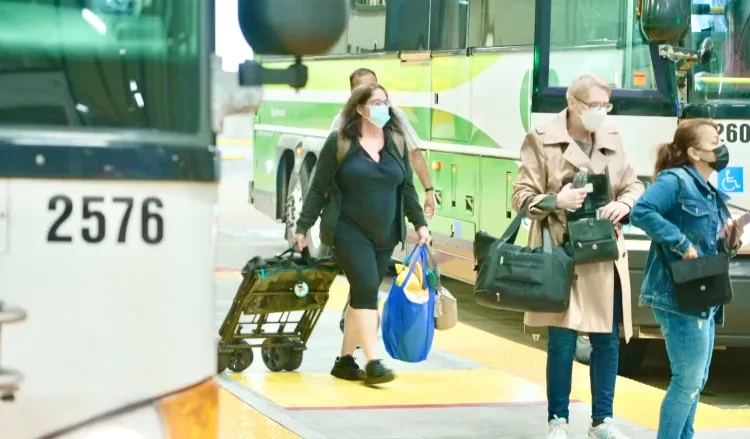People are driving and traveling again, but public transit use remains sluggish
For several years, Luis Virla would hop on a bus and then transfer to a train as part his commute to work in Calgary. But like many, once the pandemic began, he hit the brakes on using transit.
Even now with pandemic restrictions nearly gone and his anxiety about catching the virus easing, the 36-year-old still isn’t shuttling through Calgary on transit for his job at a technology startup. Instead, he spends most work days at home.
If he needs to go into the office, he’ll either drive or catch a ride.
“I have taken transit very little since the pandemic,” said Virla.
As part of a family of four, including two young kids, he realizes he’ll have to get back into the habit of using the bus and train eventually because of his one-car household.
“I would definitely take transit again, but I probably wouldn’t want to be commuting everyday,” he said, preferring more flexibility.
Transit ridership across the country is still noticeably down compared to pre-pandemic levels, even as more people return to the office and gas prices hit record-setting highs.

Long recovery ahead
While vehicle use and air travel have nearly fully recovered from the pandemic, transit use may still take a few years to return to normal levels, observers said.
The most recent ridership figures from Statistics Canada come from March 2022. This was the twelfth straight month of year-over-year growth in urban transit. Still, ridership is only 52 per cent of what it was at the beginning of the pandemic in March 2020.
“The nature of work and work-related travel has changed significantly post-pandemic,” said Raktim Mitra, an associate professor at Toronto Metropolitan University’s school of urban and regional planning.
More people are walking and biking when they can, he said, and it can be tough to break the habit of driving. Some commuters are still space-conscious and worried about COVID-19, after being told to physically distance for much of the last two years, he added.
“My assumption is that it’ll take at least two, three, four years for us to go back to where we were, if we ever go back,” he said.

The most recent employment numbers show about 19 per cent of employed Canadians are still working from home, compared to 30 per cent during much of the pandemic. About five per cent have a hybrid arrangement where they split their time between the office and working from home.
Calgary has experienced among the highest recovery of downtown weekday foot traffic compared to pre-pandemic levels in North America, according to an index by commercial real estate services firm Avison Young, which uses aggregated cellphone location data.
Still, the influx of workers to the city’s core is driven mainly by car and truck. Calgary Transit’s overall ridership has increased recently, reaching about 55 per cent of pre-pandemic levels.
“Calgary is heavily influenced by people who like to drive. And our downtown market has a lot of people that historically have always wanted to drive work. So that has allowed people to feel more comfortable with regards to how they go back to the office,” said Todd Throndson, Avison Young’s managing director in Calgary.
Many commuters in the city are noticing the trains and busses can be spacious on Mondays and Fridays, while full the other days of the week; many companies only require workers to be in the office from Tuesday to Thursday.
“There are some interesting things happening with ridership in terms of that return to the office,” said Stephen Tauro, a Calgary Transit spokesperson. “We are in a transition.”
Ridership in the city is slowing picking up and is expected to gradually increase over the summer, Tauro said, with an anticipated jump in September with the return of school and more people back to the office. Still, he’s unsure when ridership will fully recover.
Uneven recovery
Transit use varies across the country, with some Ontario cities like Brampton and London reporting ridership recovering to more than 70 per cent of pre-pandemic levels. In some small cities, however, ridership is down 80 per cent compared to 2019 levels.
“I think a lot of people are returning back to work and because of that, it’s getting busier and busier by the day,” said Zain Mazhar, before he boarded a bus as part of his commute from Mississauga to Ajax, Ont.
For most of the last year, Tina Huang would usually have empty seats beside her on the bus in Toronto, but “now it’s packed in there.”
Fewer riders meant a sharp drop in transit revenues over the last few years, which was offset by billions of dollars in temporary government support. Many transit agencies are still juggling providing more routes and services to entice customers back, while trying to keep costs in check.
Some in the industry are optimistic about ridership quickly picking up across the country, especially in major cities.
This is the time when transit agencies should be planning for demand to increase, said Josipa Petrunic, president of the Canadian Urban Transit Research & Innovation Consortium, a Toronto-based non-profit group.
She anticipates hitting an inflection point as more people continue to return to the office, combined with rising immigration and population levels.
“Suddenly people are going to get really upset about a transit service that is not fast, not convenient, not on time, not getting them to where they need to get to,” she said. “Meanwhile, the gasoline price is through the roof and it’s breaking the bank.”
Overall, Petrunic expects it will take two years for transit ridership across the country to overcome the pandemic and return to 2019 ridership levels.


